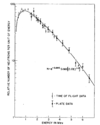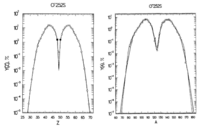Difference between revisions of "Cf252 runs with HPGe"
| Line 17: | Line 17: | ||
Decay: Cf-252 undergoes alpha decay to Curium (cm-248) 96.9% of the time. The rest of the time it will undergo spontaneous Fission emitting 3.7 neutrons on average per fission. | Decay: Cf-252 undergoes alpha decay to Curium (cm-248) 96.9% of the time. The rest of the time it will undergo spontaneous Fission emitting 3.7 neutrons on average per fission. | ||
| − | |||
| − | The Fission Fragment Yield as a function Fission fragment Atomic Number (<math>Z</math>) and Atomic Mass Number (<math>A</math>). | + | |
| + | The Fission Fragment Yield as a function Fission fragment Atomic Number (<math>Z</math>) and Atomic Mass Number (<math>A</math>) from Wahl, A., At. Data and Nuc. Data Tab., vol. 39, (1988) . | ||
[[File:Cf252-FissionProductsRate_NucDatTable1988.png | 200 px]] | [[File:Cf252-FissionProductsRate_NucDatTable1988.png | 200 px]] | ||
Revision as of 22:18, 3 January 2017
Detector efficiency measurements using a Cf-252 source.
Cf-252 source description
Serial Number: FTC-CFZ-431
Mass:On 03/19/1993 the Cf-252 mass was 4.2. ( is expected to emit )
Half Life= 2.652 years
Neutron fluence:On 03/19/1993 the Cf-252 the neutron rate was . Base on the mass one would expect .
Neutron energy spectrum (from A.B.Smith et.al, Physics. Rev. Vol 108 #2 pg 411-414, 1957 File:PhysRev108p411957.pdf):
Decay: Cf-252 undergoes alpha decay to Curium (cm-248) 96.9% of the time. The rest of the time it will undergo spontaneous Fission emitting 3.7 neutrons on average per fission.
The Fission Fragment Yield as a function Fission fragment Atomic Number () and Atomic Mass Number () from Wahl, A., At. Data and Nuc. Data Tab., vol. 39, (1988) .
HpGe distribution
HpGe Neutron Damage
I made a page discussing neutron damage to the HPGe detector (Fast_neutron_damage_to_HPGe_Detector) as a function of the total amount of fast neutrons per irradiated on the detector face. is a factor of 10 below the point where damage was first observed in an experiment.
RunPlan
Object: Determine if an HpGe detector can be using to tag neutrons and identify the isotope species parent of the neutron
Runlist
12/29/16
No poly was used to shield the HPGe detector.
| Run # | RunTime [sec] | distance[cm] | n flux (Cf252 rates) |
Integral n flux |
configuration | notes |
|---|---|---|---|---|---|---|
| 5609 | 4060 | 30 | 6850 | 6850 | Cf252 in. Coincidence between HPGe and timing PMT | A ToF spectrum exists but is very hectic. Problem may be that the TDC stop is determined by a widened timing PMT pulse in coinc. with a HPGe pulse that has high timing jitter. |
| none | 1250 | 26 | 2800 | 9655 | Not taking data during this time. | |
| 5611 | 2509 | 30 | 4230 | 13885 | Cf252 in. Coincidence between HPGe and timing PMT. TDC stop was changed to always be 1200 ns after PMT timing pulse, otherwise same setup as 5609. | ToF looks good. Neutron rate approx. 3 Hz for detector 90. |
| 5613 | 10025 | 15 | 0 | 13885 | Na-22 source. Coincidence between HPGe and timing PMT | Calibration |
| 5614 | 654 | 15 | 0 | 13885 | Co-60 source. Coincidence between HPGe and timing PMT | Calibration |
go back Total n flux: 13885 n/cm^2

